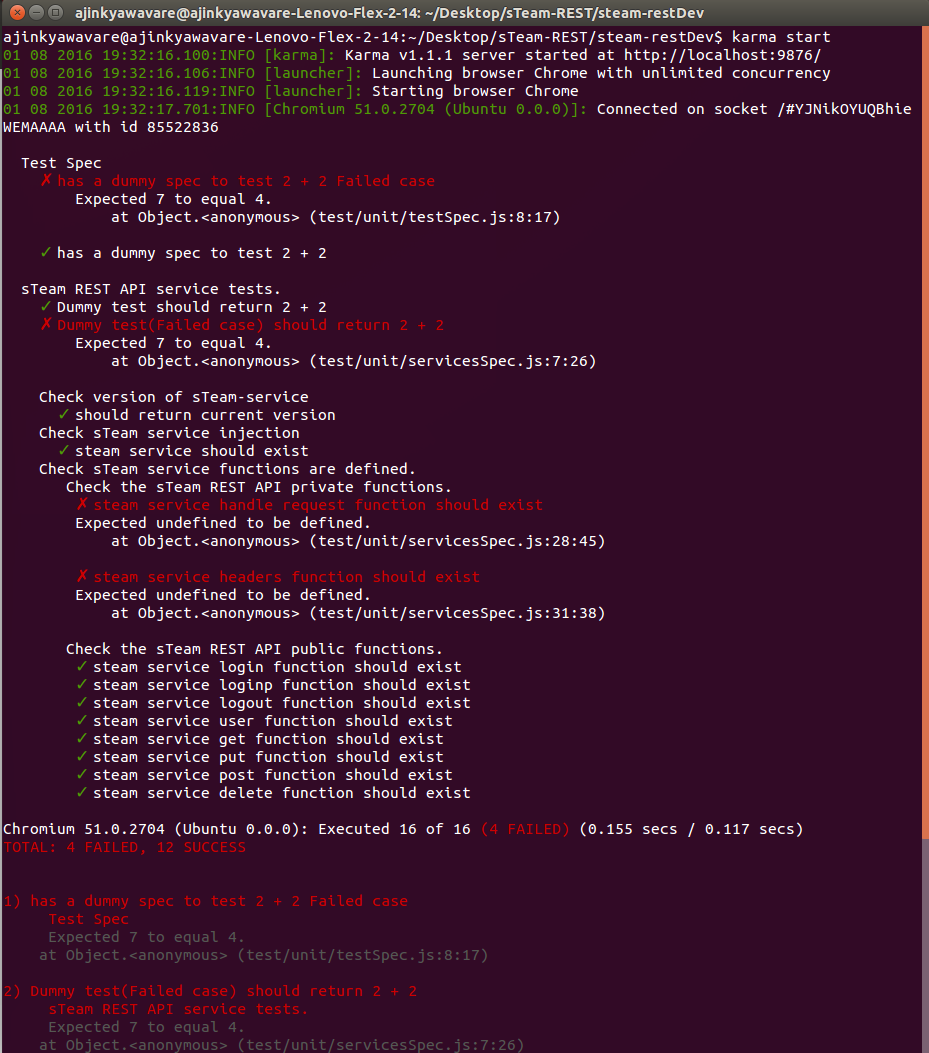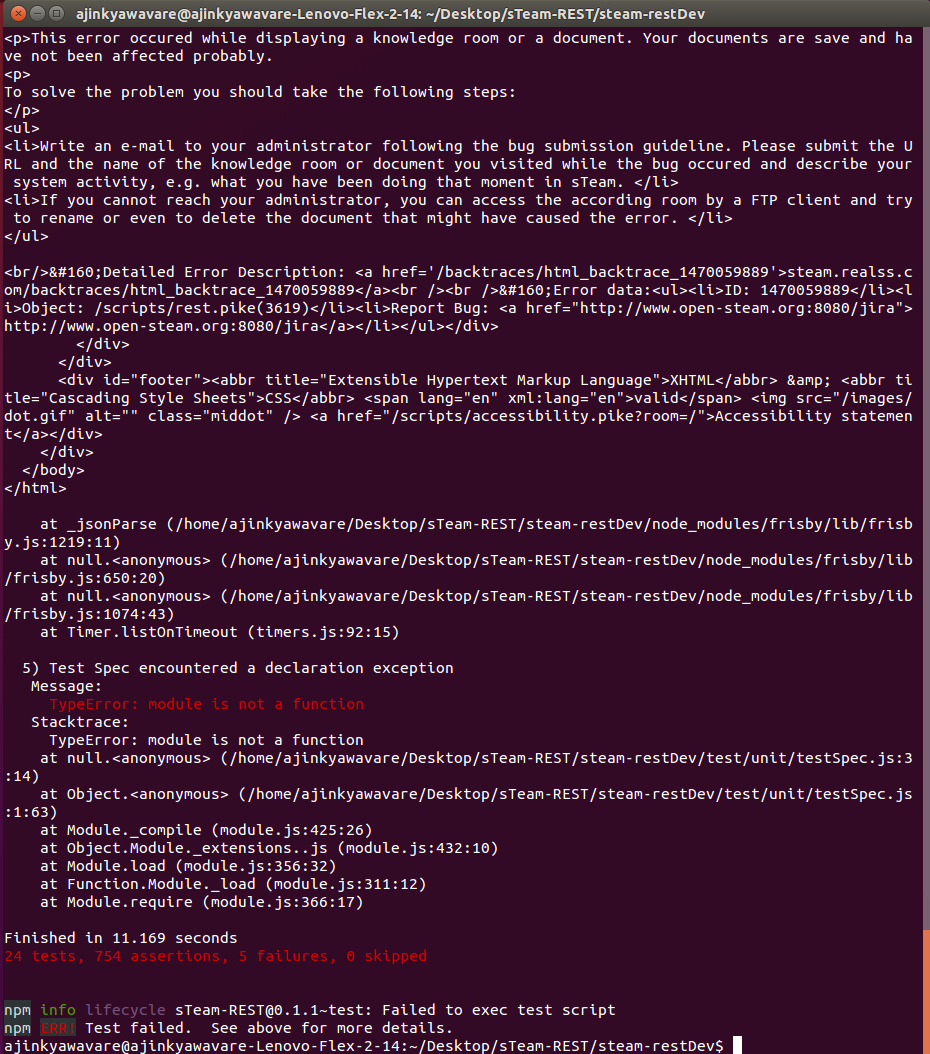
 FOSSASIA brings people together to share, create, develop and make things with Open Technologies and software. We organize science hack labs, Open Tech events, meet ups and coding programs with developers, designers and contributors.
FOSSASIA brings people together to share, create, develop and make things with Open Technologies and software. We organize science hack labs, Open Tech events, meet ups and coding programs with developers, designers and contributors.
Checkout the FOSSASIA Idea’s page for more information.
(ˢᵒᶜⁱᵉᵗʸserver) aims to be a platform for developing collaborative applications.
sTeam server project repository: sTeam.
sTeam-REST API repository: sTeam-REST
Unit Testing the sTeam REST API
The unit testing of the sTeam REST API is done using the karma and the jasmine test runner. The karma and the jasmine test runner are set up in the project repository.
The karma test runner : The main goal for Karma is to bring a productive testing environment to developers. The environment being one where they don’t have to set up loads of configurations, but rather a place where developers can just write the code and get instant feedback from their tests. Because getting quick feedback is what makes you productive and creative.
The jasmine test runner: Jasmine is a behavior-driven development framework for testing JavaScript code. It does not depend on any other JavaScript frameworks. It does not require a DOM. And it has a clean, obvious syntax so that you can easily write tests.
The karma and jasmine test runner were configured for the project and basic tests were ran. The angular js and angular mocks version in the local development repository was different. This had resulted into a new error been incorporated into the project repo. The ‘angular.element.cleanData is not a function’ error is thrown in the local development repository. This error happens when the local version of the angular.js and angular-mocks.js doesn’t match. The testing framework would test you if the versions f the two libraries is not the same.
The jasmine test runner can be accessed from the browser. The karma tests can be performed from the command line.
To access the jasmine test runner from the web browser, go to the url
http://localhost:7000/test/unit/runner.html
To run the karma test suite, run the following command
$ karma start
The unit tests of the sTeam REST service were done using jasmine. The unit tests were written in coffee script. The preprocessor to compile the files from coffee script to javascript is defined in the karma configuration file.
Jasmine Test Runner
First a dummy pass case and a fail case is tested to check there are no errors in the test suite during the test execution.
The localstoragemodule.js which is used in the steam service is injected in the test module. Then the steam service version is tested.
describe 'Check version of sTeam-service', ->
it 'should return current version', inject (version) ->
expect(version).toEqual('0.1')
steam service should be injected in a global variable as the same service functions shall be tested while performing the remaining tests.
Then the steam service is injected and checked whether it exists or not.
beforeEach inject (_steam_) -> steam= _steam_ describe 'Check sTeam service injection', -> it 'steam service should exist', -> expect(steam).toBeDefined()
The sTeam service has both private and public functions. The private functions cannot be accessed from outside. The private functions defined in the sTeam service arehandle_request and headers.
describe 'Check sTeam service functions are defined.', -> describe ' Check the sTeam REST API private functions.', -> it 'steam service handle request function should exist', -> expect(steam.handle_request).toBeDefined() it 'steam service headers function should exist', -> expect(steam.headers).toBeDefined()
The public functions of the sTeam service are then tested.
describe 'Check sTeam service functions are defined.', -> describe ' Check the sTeam REST API public functions.', -> it 'steam service login function should exist', -> expect(steam.login).toBeDefined() it 'steam service loginp function should exist', -> expect(steam.loginp).toBeDefined() it 'steam service logout function should exist', -> expect(steam.logout).toBeDefined() it 'steam service user function should exist', -> expect(steam.user).toBeDefined() it 'steam service get function should exist', -> expect(steam.get).toBeDefined() it 'steam service put function should exist', -> expect(steam.put).toBeDefined() it 'steam service post function should exist', -> expect(steam.post).toBeDefined() it 'steam service delete function should exist', -> expect(steam.delete).toBeDefined()
The test suite written by Siddhant for the sTeam server was tested. The merging of the code from different branches which includes the work done during the course of GSoC 2016 will be merged subsequently.
Karma test runner
Feel free to explore the repository. Suggestions for improvements are welcomed.
Checkout the FOSSASIA Idea’s page for more information on projects supported by FOSSASIA.




